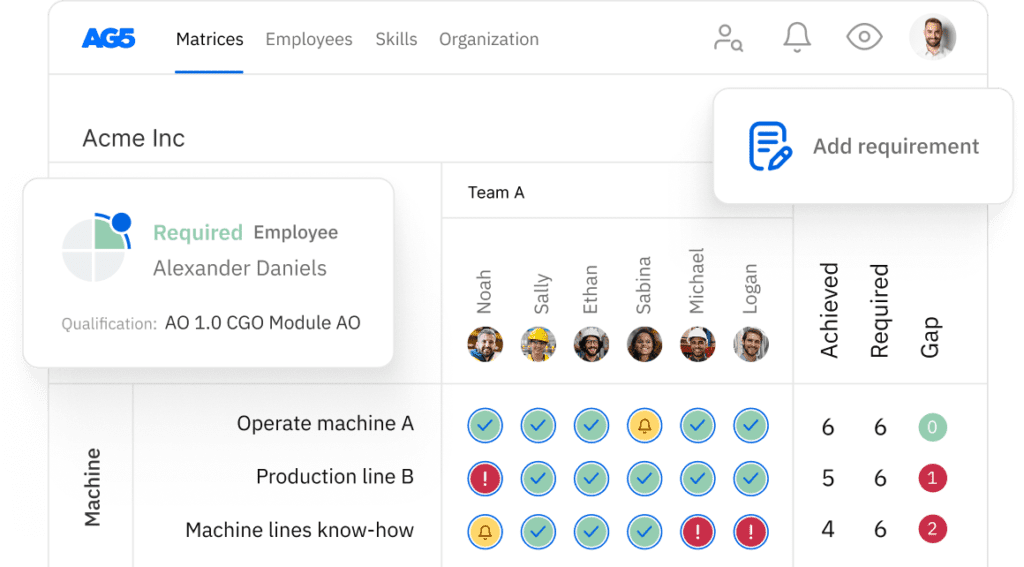Green jobs and the skills gap: Navigating the transition to a sustainable workforce
In this article, we discuss the rise of green jobs and the skills gap they create. It explores strategies for bridging this gap through education, training, and AG5’s skills management software.

As the world grapples with the challenges of climate change, there is a growing need for a transition to sustainable practices across industries. This transition has sparked a boom in green jobs, which are focused on creating a more environmentally friendly and sustainable future.
The rapid growth of green jobs, however, has also highlighted a significant skills gap, with a recent Fast Company article revealing that “the demand for green jobs is outpacing the production of green talent,” with more than 800 million jobs vulnerable to climate change and the necessary changes that industries must make to address it.
In this article, we will explore the rise of green jobs, the skills required to thrive in them, and how you can address the skills gap they may cause.
What are green jobs? Copied
“Green jobs” refer to jobs that contribute to preserving or improving the environment, as well as promoting sustainable practices and the transition to a low-carbon economy. They are typically focused on addressing environmental challenges, such as climate change, pollution, resource depletion, and biodiversity loss.
Sectors most affected by the need for green jobs include energy, energy efficiency, sustainable agriculture, waste management, and green construction, with common job titles being:
- Renewable Energy Technician
- Energy Efficiency Auditor
- Sustainable Transportation Planner
- Environmental Engineer
- Green Building Architect
- Environmental Scientist
- Recycling Coordinator
- Green Business Consultant
It is important to note, however, that organizations in all industries can benefit from green jobs. The goal here is to foster a culture of sustainability, with all departments, teams, and roles doing their part to increase overall sustainability – for both financial and ethical reasons.
Why are green jobs beneficial to organizations? Copied
It should come as no surprise that green jobs bring with them a wide range of benefits. By prioritizing the development of green skills – thus paving the way for green jobs – organizations can embrace sustainability, seize opportunities in the green economy, and work towards a more equitable future.
These benefits make green jobs an attractive and valuable investment for organizations committed to a sustainable future. Here, we’ll take a look at several of them.
Enhanced corporate social responsibility (CSR)
Green jobs enable organizations to demonstrate their commitment to environmental sustainability, aligning with CSR objectives. By promoting green practices and employing individuals in green roles, organizations contribute to positive environmental impacts and improve their reputation among stakeholders.
Cost savings
Green jobs often focus on energy efficiency, waste reduction, and resource conservation, green jobs. By employing individuals with expertise in these areas, organizations can identify and implement cost-saving measures, such as energy-efficient technologies, waste management strategies, and sustainable procurement practices.
Market opportunities
The transition to a low-carbon economy opens up new market opportunities. By investing in green jobs and sustainable practices, organizations position themselves to capitalize on growing consumer demand for environmentally friendly products and services. This can lead to increased market share, customer loyalty, and competitive advantages.
Innovation and adaptability
Skilled individuals in green roles bring fresh perspectives, knowledge of emerging technologies, and expertise in sustainable practices. This fosters a culture of innovation, allowing organizations to adapt to changing environmental regulations, consumer preferences, and industry trends.
Employee engagement and attraction
Many individuals are passionate about sustainability and seek purpose-driven work. By offering green job opportunities, organizations can create a more engaged workforce, boost employee morale, and attract environmentally conscious professionals who align with the organization’s values.

What challenges does the green skills gap pose to organizations?Copied
A “skills gap” refers to the mismatch between the skills required for (green) jobs and the skills possessed by the available workforce. Because green jobs are a relatively new phenomenon, there are currently too-few employees who possess the specialized skills or certifications required to fill them.
Before you can take steps to close the green skills gap, however, it is important to understand why this green skills gap exists. In this section, we’ll take a look at several factors that are attributed to the green skills gap.
- Technological advancement. The rapid development of green technologies often outpaces formal education and training programs.
- Educational disparity. Traditional education systems often struggle to keep pace with the rapidly evolving needs of the green job market, resulting in a shortage of skilled professionals.
- Evolving skill sets. Green jobs demand a combination of technical, analytical, and soft skills, including expertise in renewable energy technologies, sustainability practices, data analysis, project management, and collaboration. These skills may differ from those required in traditional industries.
- Awareness and perception. A lack of awareness and misconceptions about green jobs contribute to a limited talent pool, hindering the growth of the sector.
How can you bridge the green skills gap?Copied
Addressing the green job skill gap requires a multi-faceted approach that involves developing and expanding educational programs and vocational training that focus on green skills and technologies.
In this section, we’ll look at several strategies you and your organization can take to navigate the challenges posed by the green skills gap. By implementing such strategies, organizations can contribute to narrowing the green skills gap with a finely tuned workforce that can effectively contribute to the transition to a sustainable and low-carbon economy.
Collaboration with educational institutions
Partner with universities, colleges, and vocational training centers to develop or enhance green curriculum that aligns with industry needs. This collaboration can include advisory boards, guest lectures, internships, and practical training opportunities.
Internal training and upskilling
Offer training programs and workshops to upskill existing employees, providing them with the necessary knowledge and competencies for green jobs. This can include specialized training on renewable energy, energy efficiency, sustainable practices, and environmental regulations.
Apprenticeships and internships
Establish apprenticeship programs or internships focused on green jobs to provide hands-on training and practical experience to individuals interested in pursuing careers in the green sector. This can help bridge the gap between education and employment.
Collaboration with industry associations
Engage with industry associations and professional networks to share best practices, collaborate on skill development initiatives, and collectively address the green skills gap. These associations often offer resources, training programs, and certifications that can benefit both organizations and individuals.
Continuous learning and professional development
Encourage employees to engage in continuous learning and professional development related to green skills. This can involve providing access to online courses, industry conferences, and workshops focused on sustainability and environmental best practices.
Recruitment and talent acquisition
Actively recruit individuals with relevant green skills and experience, leveraging specialized job boards, networking events, and partnerships with environmental organizations. This approach ensures that organizations bring in talent already equipped with the necessary skills for green jobs.
How can AG5 help you bridge the green skills gap?Copied
AG5’s skills management software plays a large role in helping your organization identify and close green skills gaps. Using our intuitive platform, you will be poised to close skills gaps caused by green jobs – or prevent them from occurring entirely.
Using AG5, you will:
Identify green skills
With a clear overview of the skills that the employees in your organization possess, you can use AG5 to easily identify and categorize specific green skills required for various roles – helping align workforce capabilities with the skills needed for green jobs.
Assess green skills gaps
Using the overview of skills – including those necessary for green jobs – you can easily determine where additional training or recruitment may be necessary. This will provide you with insight into the skills and competencies that employees need to develop or acquire to excel in green roles.
Support planning and development
Using AG5 to track and monitor training or certification progress, you can prevent skills gaps before they occur, giving your organization an edge in a sector that is extraordinarily competitive.
Place a focus on compliance and certification management
AG5 supports compliance management by tracking employee certifications, licenses, and compliance requirements related to green jobs. This ensures that all employees possess the necessary credentials and certifications required to work in environmentally sensitive, highly regulated areas.
Ready to get started?Copied
If you’re ready to take the next step in closing the green skills gap, schedule a free, live, 15-minute demo of AG5’s skills management software. There, you will see our platform in action, with a front-row seat to our seamless, intuitive solution to skills management.
Don’t know where to start? Talk to our skills experts.
Request a live demo
Schedule a live demo of the only plug and play skills management software!
